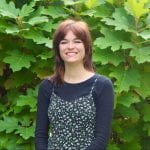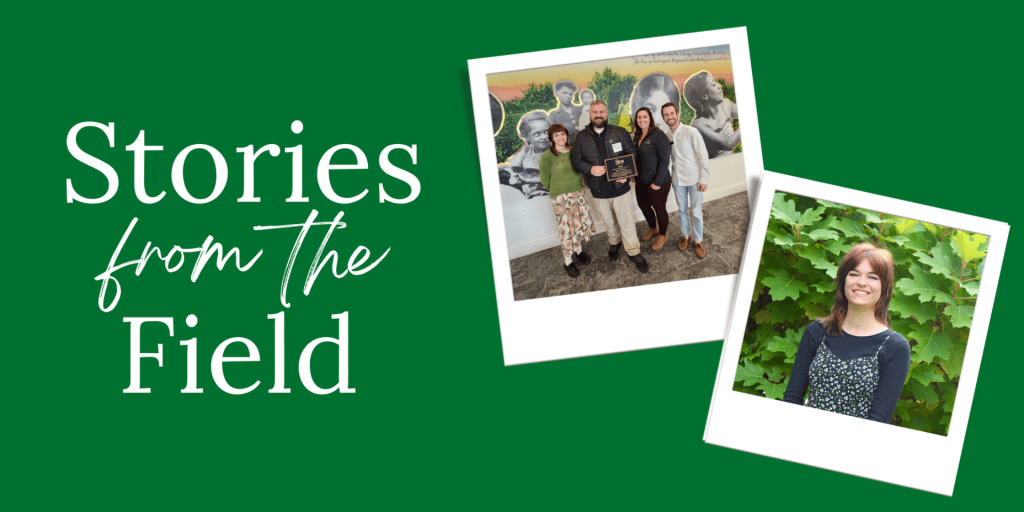by Lanier Fussell, Rural Energy Specialist, Wy’East Resource Conservation & Development
About five months ago from the time I am writing this, I was at the RARE Program Orientation discussing results of a strengths assessment. The assessment had named context as my dominant theme. My results explained that I understand things best after taking the time to understand the complete background. I began to feel uneasy as I looked over the list of strengths and noticed the ones I didn’t identify with. The RARE motto of “getting things done” echoed through my mind as I read about themes like activator, developer, command, and achiever.
 Still wondering how I’d make it in this program without the skills of a commanding achiever, I started my service year in September with Wy’East Resource Conservation and Development Council. I spent my first month at Wy’East sitting in on meetings and learning the ins and outs of USDA’s Rural Energy for America Program. In my position, my primary responsibility is to help agricultural producers and rural small businesses apply for grants to make their businesses more energy efficient or install renewable energy systems. I help applicants by verifying applicant eligibility, decoding federal regulation, providing technical writing assistance, and compiling a final grant application in compliance with USDA requirements. I shadowed Michael, a Wy’East staff member who had served in my current RARE position the year before, in meetings with new REAP leads.
Still wondering how I’d make it in this program without the skills of a commanding achiever, I started my service year in September with Wy’East Resource Conservation and Development Council. I spent my first month at Wy’East sitting in on meetings and learning the ins and outs of USDA’s Rural Energy for America Program. In my position, my primary responsibility is to help agricultural producers and rural small businesses apply for grants to make their businesses more energy efficient or install renewable energy systems. I help applicants by verifying applicant eligibility, decoding federal regulation, providing technical writing assistance, and compiling a final grant application in compliance with USDA requirements. I shadowed Michael, a Wy’East staff member who had served in my current RARE position the year before, in meetings with new REAP leads.
I wrote down every bit of information I learned, trying to connect the dots. Agricultural producers are only eligible if at least 50% of their gross income comes from agricultural operations. All projects must use commercially available technology. Projects with a total project cost of more than $200,000 require a one-line electrical drawing and structural drawing of solar structure and racking system. Small business size limits depend on the entity’s NAICS code. Most nebulous of all was the application process.
This was a commonly asked question with no solid answer. The consensus seemed to be that there was no clear process, you just had to chase down the information you needed until you had it, and then you put it where it belongs in the application. Each project was too different to develop a repeatable process.
On one quiet and meeting-less afternoon, I embarked on a mission to try anyway. I had the time and resources, so how hard could it be? Using a timeline-based project management tool, I arranged all the pieces of an application – federal forms, utility bills, environmental screenings, business documents, production reports – into something that resembled a flowchart. It functioned as a to-do list that denoted which tasks had to be done before others could be started. As I worked through my list, the seemingly unrelated details I’d learned started to click together.
After a few months, the time came for me to lead conversations with REAP applicants. My first solo mission was to call a potential applicant who was looking for guidance after trying to read through the regulation himself. I stayed quiet as I listened to him express his confusion, conscious of my role as a technical assistance provider. I wanted to appear knowledgeable and dependable, but I had felt exactly how he did a couple months ago. I thought back to the tools I had made for myself and wondered if other people would find it helpful.
I condensed the process flowchart I had made into one document, broken up into three phases. I color-coded the tasks in this cart  to denote if the tasks were to be completed by the applicant, the project developer, or Wy’East. In my next meeting with an applicant, I tentatively mentioned that I had a document that might help clarify the process. I shared my screen and began explaining the connections, growing increasingly nervous. Surely I was the only person that needed to look at the applications this way– I was just wasting this person’s precious time. I held my breath.
to denote if the tasks were to be completed by the applicant, the project developer, or Wy’East. In my next meeting with an applicant, I tentatively mentioned that I had a document that might help clarify the process. I shared my screen and began explaining the connections, growing increasingly nervous. Surely I was the only person that needed to look at the applications this way– I was just wasting this person’s precious time. I held my breath.
“Can I get a copy of this?” the applicant replied. “I feel like I’m finally getting it.” I began to bring up the flowchart and other representations I had made more often. I found that approaching the process in context, rather than focusing on the details and requirements, had the best impact in informational meetings with curious producers and business owners. Leaning into my strengths translated into more outreach based responsibilities at Wy’East, culminating in my current project of improving our online presence. Our website is our most effective way of sharing information with the community, and in this work I’ve focused on how to make our shared knowledge and program information as accessible as possible.
Five months into my service year, I no longer worry that I have the wrong strengths for this work. I learned that getting things done isn’t only about marching ahead and blazing a trail– progress is most effective when the time is taken to share knowledge.
 About the author, Lanier Fussell: Lanier is originally from Little Rock, Arkansas. In 2022, she graduated from Louisiana State University with a B.A. in International Studies accompanied by a concentration in Environment and Development. At LSU, she was a student worker in the Department of Political Science, an English language tutor, and a volunteer at the local animal shelter. She spent the summer of 2021 as a Livestock Volunteer with Heifer Ranch in Perryville, Arkansas. After graduation, Lanier spent six months as an English Language Assistant in Montbéliard, France. By gaining experience working at the intersection of energy and agriculture this year, Lanier intends to spend her career mitigating the effects of climate change on agriculture and food systems. In her free time, you can find Lanier painting, knitting, watching college football (Geaux Tigers), or taking too many pictures of her cat, Toaster.
About the author, Lanier Fussell: Lanier is originally from Little Rock, Arkansas. In 2022, she graduated from Louisiana State University with a B.A. in International Studies accompanied by a concentration in Environment and Development. At LSU, she was a student worker in the Department of Political Science, an English language tutor, and a volunteer at the local animal shelter. She spent the summer of 2021 as a Livestock Volunteer with Heifer Ranch in Perryville, Arkansas. After graduation, Lanier spent six months as an English Language Assistant in Montbéliard, France. By gaining experience working at the intersection of energy and agriculture this year, Lanier intends to spend her career mitigating the effects of climate change on agriculture and food systems. In her free time, you can find Lanier painting, knitting, watching college football (Geaux Tigers), or taking too many pictures of her cat, Toaster.
Interested in gaining sustainability and environmental planning experience of your own? Are you looking for a life changing experience in rural Oregon? Learn more about serving with the RARE AmeriCorps Program. Applications for Year 31 (2024-25) due April 28, 2024 by 11:59pm PDT.

